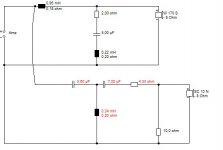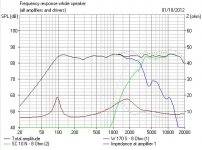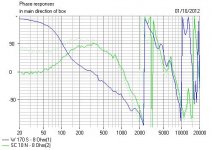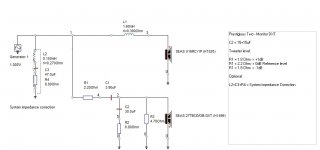Author:
I know what you might be thinking-first order electrical will not protect the tweeter enough. It will suffer excess distortion. That's what I thought might happen. However, distortion testing has shown that not to be the case. See my blog for the confirmatory graphs if you remain unconvinced. However, success hinged on using low distortion drivers, and a topology that fairly rapidly attenuates the tweeter 15-20 dB at the crossover.
I know what you might be thinking-first order electrical will not protect the tweeter enough. It will suffer excess distortion. That's what I thought might happen. However, distortion testing has shown that not to be the case. See my blog for the confirmatory graphs if you remain unconvinced. However, success hinged on using low distortion drivers, and a topology that fairly rapidly attenuates the tweeter 15-20 dB at the crossover.
I've edited and added some info in my post #20, but now it is on another page:
http://www.diyaudio.com/forums/multi-way/220694-erse-inductors-europe-2.html#post3185315
http://www.diyaudio.com/forums/multi-way/220694-erse-inductors-europe-2.html#post3185315
Well, I don't know what you're going to do, my friend.
IMO, it's a rubbish design. He's just thrown a couple of random notches at the tweeter to get the frequency response flat. Really C4 should be around 50uF to hit 900Hz.
The bass, I like:
Sample projects
But I could be wrong. And I expect you could fit the SEAS Idunn tweeter filter anyway.
I'm all for folks developing a loudspeaker according to their own design goals but "rubbish?" A bit much, don't you think?
Quite a bit of time and thought went into this specific design. The entire idea was to take the power response of the dxt lens and and extend it down the frequency spectra with a carefully chosen crossover topology. The crossover is exactly as it needs to be to execute a flat on axis response and a notably smoother off axis response than the majority of more conservative designs. It places quite a demand on the tweeter. Unlike some of the armchair modeling jockeys posting, my measurements seem to back up my implementation quite well.
I described the design choices in detail.
I executed a network that achieved the these targets.
I provided a number of measurements to prove that I met the targets.
In a group setting the speaker was well received.
The design, as it stands has a commendably flat on axis frequency response, a notably smoother off axis response than any other non waveguide project mentioned here (and most not mentioned here!) and the distortion measurements to prove the tweeter can handle the stress.
If the unconventional design scares you, or you feel your design skills aren't up to snuff, by all means, build a more typical 2 way third or fourth order design. Skip the dxt while you're at it. Of course, then you have just another of the ten million generic two way designs out there.
I'm not saying this is the "ultimate," "best," blah, blah, blah speaker. It may indeed not be your cup of tea. But the above critique falls along the line of "I like Porsche, BMW are rubbish."
PS- You can build it or not build it. If you do, don't change C4 to 50 uF
No, it's rubbish Mark. About the worst treble filter I've ever seen. 
Here's why. You've done great things with the bass. I really like the notch on the bass which cuts out a lot of cone breakup and linearises the phase nicely. But that single capacitor and TWO notches are TERRIBLE. A second or third order treble filter with appropriate attenuation is The SEAS Solution for the DXT and it's mine too.
The Fs resonance is WAY lower, which stops it sounding like a "Little Girl with a Guitar" optimised speaker and the phase is almost perfect. Zaph and friends may like your simple crossover, but he too often does some odd things in my opinion. Someone has to say the Emperor has no clothes sometime. Thanks for speaking up though. Look forward to the Mark 2 version which will be REALLY good.
My 3rd order sim below. Bit rough and ready, I used different drivers and the 7uF is rather optional. But you KNOW it makes sense.
Here's why. You've done great things with the bass. I really like the notch on the bass which cuts out a lot of cone breakup and linearises the phase nicely. But that single capacitor and TWO notches are TERRIBLE. A second or third order treble filter with appropriate attenuation is The SEAS Solution for the DXT and it's mine too.
The Fs resonance is WAY lower, which stops it sounding like a "Little Girl with a Guitar" optimised speaker and the phase is almost perfect. Zaph and friends may like your simple crossover, but he too often does some odd things in my opinion. Someone has to say the Emperor has no clothes sometime. Thanks for speaking up though. Look forward to the Mark 2 version which will be REALLY good.
My 3rd order sim below. Bit rough and ready, I used different drivers and the 7uF is rather optional. But you KNOW it makes sense.
Attachments
No, it's rubbish Mark. About the worst treble filter I've ever seen.
Here's why. You've done great things with the bass. I really like the notch on the bass which cuts out a lot of cone breakup and linearises the phase nicely. But that single capacitor and TWO notches are TERRIBLE. A second or third order treble filter with appropriate attenuation is The SEAS Solution for the DXT and it's mine too.
The Fs resonance is WAY lower, which stops it sounding like a "Little Girl with a Guitar" optimised speaker and the phase is almost perfect. Zaph and friends may like your simple crossover, but he too often does some odd things in my opinion. Someone has to say the Emperor has no clothes sometime. Thanks for speaking up though. Look forward to the Mark 2 version which will be REALLY good.
My 3rd order sim below. Bit rough and ready, I used different drivers and the 7uF is rather optional. But you KNOW it makes sense.
You still don't have seem to understand.
Here is the off axis curves for the Idunn,
An externally hosted image should be here but it was not working when we last tested it.
Here's mine.
An externally hosted image should be here but it was not working when we last tested it.
What can I say? Equally flat on axis response, better off axis response, and graphs showing commendable distortion performance.
Nothing wrong with the Idunn. It's polished in the way a Honda Accord is polished. It's just like all the other two way designs out there, a standard, if somewhat dullard of a crossover meant to showcase Seas' drivers. Still it suffers from a more uneven off axis response, and thus, on the basis of measurements alone, is inferior.
Even if you're not into measurements as all that important it still did very well in a large group listening eval. I can't say for sure which would win in a head to head listening competition since the Idunn wasn't there. (And I wouldn't presume to guess what the Idunn sounds like-just that the crossover is a dullard.)
I guess it depends on whether you think a smoother power response is important. It seems that you can't seem to think outside the box (sorry to use that cliche), so keep on driving your Accord/Camry kind of two way.
Anyway, I don't want to get into a big war. The comments you've posted about the tweeter's Fs and where to put the notch doesn't always apply and a good designer knows what he can "get away with," in order to meet a design goal.
Anyway, not much more to say to you personally. I've made it quite clear what my design goals were and how I achieved them. I've got the measurements to back them up as well as, again, some comments in a large group setting. Folks will have decide for themselves based on the strength of the data presented whether or not to try a more innovative design.
You still don't have seem to understand.
Here is the off axis curves for the Idunn,
An externally hosted image should be here but it was not working when we last tested it.
Here's mine.
An externally hosted image should be here but it was not working when we last tested it.
What can I say? Equally flat on axis response, better off axis response, and graphs showing commendable distortion performance.
Nothing wrong with the Idunn. It's polished in the way a Honda Accord is polished. It's just like all the other two way designs out there, a standard, if somewhat dullard of a crossover meant to showcase Seas' drivers. Still it suffers from a more uneven off axis response, and thus, on the basis of measurements alone, is inferior.
Even if you're not into measurements as all that important it still did very well in a large group listening eval. I can't say for sure which would win in a head to head listening competition since the Idunn wasn't there. (And I wouldn't presume to guess what the Idunn sounds like-just that the crossover is a dullard.)
I guess it depends on whether you think a smoother power response is important. It seems that you can't seem to think outside the box (sorry to use that cliche), so keep on driving your Accord/Camry kind of two way.
Anyway, I don't want to get into a big war. The comments you've posted about the tweeter's Fs and where to put the notch doesn't always apply and a good designer knows what he can "get away with," in order to meet a design goal.
Anyway, not much more to say to you personally. I've made it quite clear what my design goals were and how I achieved them. I've got the measurements to back them up as well as, again, some comments in a large group setting. Folks will have decide for themselves based on the strength of the data presented whether or not to try a more innovative design.
I agree with Mark,
There is nothing strange with using a first-order electrical filter + notches with the DXT tweeter. I have done the same with my Prestigious Two – Monitor DXT design. There is nothing "rubbish" about it, just another way to design and to achieve the design goal.
The DXT tweeter is very well suited for using a simple first-order + some contour shaping circuit, actually this is the way to make the full potential of it and to make it sing. I've tested several more "conventional" passive filters as well as active ones and the best so far is the simple one I describe in the picture.
Regards
/Göran
Attachments
Sure, nothing if system in whole plays nice to our ears.There is nothing strange with using a first-order electrical filter + notches with the DXT tweeter.
Just my notes: DXT is waveguided and designed as "directed" driver. That was the goal of DXT technology, offered by Seas. With notching it (especially on 6Khz - that notching does not look good to me on THIS design) you get hole in response of tweeter, which filled with response of woofer to achive flat responce. So, directivety of DXT is suffered a bit on certain freq and filled with wider directivity of woofer's response - that is why this design have better plots on of-axis measurements. It could be bad or it could be good - only listening test can confirm it. But ER18RNX's response @6kHz is not the best. That is the only what (possibly) bad could be.
Question to Mark: do you have driver's measurements in-cabinet to play with it? If so, would it be possible to get it in some importable format (Freq | Mag | Db), if possible.
Note to System7: do not play much with Visaton's boxsim - it is "thing on it's own" and far from the truth if you measure speakers with microphone. It is good just to play with Visaton's constructions, see crossover response, but nothing else.
P.S: All the speakers are compromise in terms of design and SQ
Sure, nothing if system in whole plays nice to our ears.
Just my notes: DXT is waveguided and designed as "directed" driver. That was the goal of DXT technology, offered by Seas. With notching it (especially on 6Khz - that notching does not look good to me on THIS design) you get hole in response of tweeter, which filled with response of woofer to achive flat responce. So, directivety of DXT is suffered a bit on certain freq and filled with wider directivity of woofer's response - that is why this design have better plots on of-axis measurements. It could be bad or it could be good - only listening test can confirm it. But ER18RNX's response @6kHz is not the best. That is the only what (possibly) bad could be.
Question to Mark: do you have driver's measurements in-cabinet to play with it? If so, would it be possible to get it in some importable format (Freq | Mag | Db), if possible.
Note to System7: do not play much with Visaton's boxsim - it is "thing on it's own" and far from the truth if you measure speakers with microphone. It is good just to play with Visaton's constructions, see crossover response, but nothing else.
P.S: All the speakers are compromise in terms of design and SQ
The notch at 6k doesn't cause a dip in the tweeter FR. It just, flattens a hump. See the aqua curve below. The aqua curve is the tweeter response after the network. No dip at 6k. The woofer isn't filling anything in. The woofer is twenty dB down here, which is as it should be when targeting 2nd order slopes.
An externally hosted image should be here but it was not working when we last tested it.
As to releasing the curves-I have mixed feelings about that. I'll have to think on that one.
I have a problem.
Europe audio is out of stock of 2.5 mh inductor , 0.41 ohm at 1.6 mm.
I have been trying to find alternative, but the value of 2.5 mh is for some reason not that popular.
What should I do ?
Alternatives on europe audio:
LJantzen 2.500 mH 0.590 OHm Cross CoilGBP 21.76
Jantzen 2,500mH 0,610Ohm Wax Copper Foil CoilGBP 25.59
JANTZEN-133Jantzen Wire air coil 2,500mH 0,368Ohm 1,80mm GBP 29.42
I am not that skilled to make a decision...
Thank you for help..
Europe audio is out of stock of 2.5 mh inductor , 0.41 ohm at 1.6 mm.
I have been trying to find alternative, but the value of 2.5 mh is for some reason not that popular.
What should I do ?
Alternatives on europe audio:
LJantzen 2.500 mH 0.590 OHm Cross CoilGBP 21.76
Jantzen 2,500mH 0,610Ohm Wax Copper Foil CoilGBP 25.59
JANTZEN-133Jantzen Wire air coil 2,500mH 0,368Ohm 1,80mm GBP 29.42
I am not that skilled to make a decision...
Thank you for help..
The precise DC resistance of a bafflestep/bass slope inductor is not terribly important. Nor are the rest of them, for that matter. The design seems to specify an air-core coil, so anything between 0.2 and 0.6 ohm is fine. See it's added to the DC resistance of the (6 ohm?) driver, and as a percentage, it is about 5% level loss at the worst case of 0.6 ohm. If you can hear that, I'd be surprised. But you'd compensate by increasing the series tweeter resistor if fussy. 
There is a school of thought that ferrite cored coils are to be avoided with AlNiCo magnets or Neodymium, but less critical with ferrite magnet loudspeakers.
There is a school of thought that ferrite cored coils are to be avoided with AlNiCo magnets or Neodymium, but less critical with ferrite magnet loudspeakers.
I've stumbled upon this thread by accident. WOW System7, you really shouldn't be giving advice on loudspeaker design. I hope this sort of misinformation doesn't scare off potential builders.
Mark's design is 100% right on and the ER18DXT is possibly one of the best 2-way monitor around.
Low distortion (thanks to two very capable Seas drivers) and fantastic off-axis and power response.
2nd order acoustic slopes, as in the ER18DXT, will only have 180 degrees of phase wrap. 4th order designs have 360 degrees, the group delay is significantly worse.
Another design which attempts this task is Zaph's ZD5. It too uses 2nd order acoustical slopes. But whereas the ER18DXT was able to achieve perfect time alignment via the DXT's waveguide (which gives the proper tweeter off-set), Zaph's ZD5 uses an all-pass lattice network. Unfortunately, an all-pass network (in addition to the 2nd order acoustic slope) makes for a 360 degree phase wrap. The ZD5 will still retain an excellent power response.
The only commercial company (which I know of) doing 2nd order acoustic slopes is Dynaudio. They too however use an all-pass filter on the tweeter. I've never seen Thiel and Vandersteen measure well, or hit the claimed targets...
Mark's ER18DXT
Zaph Audio's ZD5
Dynaudio
These three are the "Holy Grail" of loudspeakers. Considering that Mark's design only has 180 degrees of phase wrap (lowest group delay, the other two are 360), should make it for an excellent sounding two-way monitor.
4th order acoustic slope crossovers are the easiest to make. The speakers literally design themselves with 2 components in the crossover. We listen to 4th order every day... From computer speakers, to movie theaters, to EVERYTHING sold at local electronic stores like Best Buy.
2nd order acoustic slope crossovers are incredibly complex, even if they don't look it on paper. Very few people have actually heard them. They can sound incredible.
Mark's design is 100% right on and the ER18DXT is possibly one of the best 2-way monitor around.
Low distortion (thanks to two very capable Seas drivers) and fantastic off-axis and power response.
2nd order acoustic slopes, as in the ER18DXT, will only have 180 degrees of phase wrap. 4th order designs have 360 degrees, the group delay is significantly worse.
Another design which attempts this task is Zaph's ZD5. It too uses 2nd order acoustical slopes. But whereas the ER18DXT was able to achieve perfect time alignment via the DXT's waveguide (which gives the proper tweeter off-set), Zaph's ZD5 uses an all-pass lattice network. Unfortunately, an all-pass network (in addition to the 2nd order acoustic slope) makes for a 360 degree phase wrap. The ZD5 will still retain an excellent power response.
The only commercial company (which I know of) doing 2nd order acoustic slopes is Dynaudio. They too however use an all-pass filter on the tweeter. I've never seen Thiel and Vandersteen measure well, or hit the claimed targets...
Mark's ER18DXT
Zaph Audio's ZD5
Dynaudio
These three are the "Holy Grail" of loudspeakers. Considering that Mark's design only has 180 degrees of phase wrap (lowest group delay, the other two are 360), should make it for an excellent sounding two-way monitor.
4th order acoustic slope crossovers are the easiest to make. The speakers literally design themselves with 2 components in the crossover. We listen to 4th order every day... From computer speakers, to movie theaters, to EVERYTHING sold at local electronic stores like Best Buy.
2nd order acoustic slope crossovers are incredibly complex, even if they don't look it on paper. Very few people have actually heard them. They can sound incredible.
I cut mdf slightly longer. Which adds about 3 litres to volume. I can cut it to dimensions, but it looks good now.
will 3 extra litres worsen sq or not ?
The extra 3 liters will give you better bass extension (and possibly lower q), if you tune the port/box stuffing right. I would leave it
Surprise surprise  thread is alive.
thread is alive.
I am slowly heading towards the end. Everything is ready, only put together and veneer left.
Hopefully few weeks later will report on result.
Ridikas, I still have not glued port (kept same as per bom) , can you advise me on tuning please, what to do - cut, buy longer or bigger diameter ?
I am slowly heading towards the end. Everything is ready, only put together and veneer left.
Hopefully few weeks later will report on result.
Ridikas, I still have not glued port (kept same as per bom) , can you advise me on tuning please, what to do - cut, buy longer or bigger diameter ?
- Status
- This old topic is closed. If you want to reopen this topic, contact a moderator using the "Report Post" button.
- Home
- Loudspeakers
- Multi-Way
- Erse inductors in europe ?



